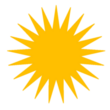Sheikh Shems
| Şêx Şems | |
|---|---|
Lord of sun, fire, light, sustenance | |
| Member of the Heptad | |
Sejadin | |
| Children | Şêx Alê Şemsa, Şêx Amadînê Şemsa, Şêx Avîndê Şemsa, Şêx Babadînê Şemsa, Şêx Bavikê Şemsa, Şêx ʿEvdalê Şemsa, Şêx Hesenê Şemsa, Şêxê Reş (Cinteyar), Şêx Tokilê Şemsa, Şêx Xidirê Şemsa, Sitya Îs (Ês), Sitiya Nisret, Sitiya Bilxan (Belqan) |
| Part of a series on the Yazidi religion Yazidism |
|---|
 |
Biography
Sêx Şems, also known as Şêşims,[3] and Şemsedîn,[4] is one of the members of the Heptad and one of the most fundamental theological symbols in Yazidism as the divinity of the Sun, source of light and life, the divine light of God. He is also linked with fire, which is his terrestrial counterpart and oaths, which are sworn by the doorway of his shrine. Annually, during the Feast of the Assembly, a ceremonial bull sacrifice is performed in front of his shrine in Lalish. Şêx Şems is the eponym of one of the four principal Şemsanî Sheikh lineages, was the patriarch of the Şemsanî family and brother of Fexredîn, Sicadîn and Nasirdîn.[5][6][7][8]
Children
The nine sons of Sheikh Shems are:[9][10]
- Şêx Alê Şemsa
- Şêx Amadînê Şemsa
- Şêx Avîndê Şemsa
- Şêx Babadînê Şemsa
- Şêx Bavikê Şemsa
- Şêx ʿEvdalê Şemsa
- Şêx Hesenê Şemsa
- Şêxê Reş (Cinteyar)
- Şêx Tokilê Şemsa
- Şêx Xidirê Şemsa
His daughters are:
- Sitiya Îs/Ês
- Sitiya Nisret
- Sitiya Bilxan (Belqan)
References
- OCLC 994778968.
- OCLC 63127403.
- ^ "Übersicht zu den "Rojîs" - den ezidischen Feier-und Fastentagen". CELLEHEUTE.DE (in German). Retrieved 2021-10-23.
- ISBN 978-3-447-05300-6.
- )
- ^ "The Yazidi mausoleums in Bozan". Mesopotamia. Retrieved 2021-10-24.
- ^ Murad, Jasim Elias (1993). The Sacred Poems of the Yazidis: An Anthropological Approach. University of California, Los Angeles. pp. 313–326.
- ISBN 978-0-7734-9004-8.
- OCLC 31377794.
- ^ Diar Khalaf and Hayri Demir. 2013. Mythos und Legende der Shex Mend und das Symbol der Schlange (Myth and legend of the Şêx Mend and the symbol of the snake) (in German).
